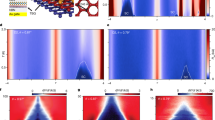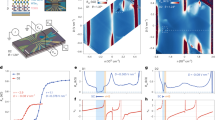Abstract
Commonly, materials are classified as either electrical conductors or insulators. The theoretical discovery of topological insulators has fundamentally challenged this dichotomy. In a topological insulator, the spin–orbit interaction generates a non-trivial topology of the electronic band structure dictating that its bulk is perfectly insulating, whereas its surface is fully conducting. The first topological insulator candidate material put forward—graphene—is of limited practical use because its weak spin–orbit interactions produce a bandgap of ~ 0.01 K. Recent reexaminations of Bi2Se3 and Bi2Te3, however, have firmly categorized these materials as strong three-dimensional topological insulators. We have synthesized the first bulk material belonging to an entirely different, weak, topological class, built from stacks of two-dimensional topological insulators: Bi14Rh3I9. Its Bi–Rh sheets are graphene analogues, but with a honeycomb net composed of RhBi8 cubes rather than carbon atoms. The strong bismuth-related spin–orbit interaction renders each graphene-like layer a topological insulator with a 2,400 K bandgap.
This is a preview of subscription content, access via your institution
Access options
Subscribe to this journal
Receive 12 print issues and online access
$259.00 per year
only $21.58 per issue
Buy this article
- Purchase on Springer Link
- Instant access to full article PDF
Prices may be subject to local taxes which are calculated during checkout



Similar content being viewed by others
References
Kane, C. L. & Mele, E. J. Z2 topological order and the quantum spin Hall effect. Phys. Rev. Lett. 95, 146802 (2005).
Kane, C. L. & Mele, E. J. Quantum spin Hall effect in graphene. Phys. Rev. Lett. 95, 226801 (2005).
Zhang, H. et al. Topological insulators in Bi2Se3, Bi2Te3 and Sb2Te3 with a single Dirac cone on the surface. Nature Phys. 5, 438–442 (2009).
Bernevig, B. A., Hughes, T. L. & Zhang, S-C. Quantum spin Hall effect and topological phase transition in HgTe quantum wells. Science 314, 1757–1761 (2006).
Fu, L., Kane, C. L. & Mele, E. J. Topological insulators in three dimensions. Phys. Rev. Lett. 98, 106803 (2007).
Wu, C., Bernevig, B. A. & Zhang, S-C. Helical liquid and the edge of quantum spin hall systems. Phys. Rev. Lett. 96, 106401 (2006).
Fu, L. & Kane, C. L. Superconducting proximity effect and Majorana fermions at the surface of a topological insulator. Phys. Rev. Lett. 100, 096407 (2008).
Akhmerov, A. R., Nilsson, J. & Beenakker, C. W. J. Electrically detected interferometry of Majorana fermions in a topological insulator. Phys. Rev. Lett. 102, 216404 (2009).
Law, K. T., Lee, P. A. & Ng, T. K. Majorana fermion induced resonant Andreev reflection. Phys. Rev. Lett. 103, 237001 (2009).
Xia, Y. et al. Observation of a large-gap topological-insulator class with a single Dirac cone on the surface. Nature Phys. 5, 398–402 (2009).
Chen, Y. L. et al. Experimental realization of a three-dimensional topological insulator, Bi2Te3 . Science 325, 178–181 (2009).
Hsieh, D. et al. Observation of time-reversal-protected single-Dirac-cone topological-insulator states in Bi2Te3 and Sb2Te3 . Phys. Rev. Lett. 103, 146401 (2009).
Kuroda, K. et al. Experimental verification of PbBi2Te4 as a 3D topological insulator. Phys. Rev. Lett. 108, 206803 (2012).
König, M. et al. Quantum spin Hall insulator state in HgTe quantum wells. Science 318, 766–770 (2007).
Brüne, C. et al. Quantum Hall effect from the topological surface states of strained bulk HgTe. Phys. Rev. Lett. 106, 126803 (2011).
Min, H. et al. Intrinsic and Rashba spin–orbit interactions in graphene sheets. Phys. Rev. B 74, 165310 (2006).
Fu, L. & Kane, C. L. Topological insulators with inversion symmetry. Phys. Rev. B 76, 045302 (2007).
Moore, J. E. & Balents, L. Topological invariants of time-reversal-invariant band structures. Phys. Rev. B 75, 121306 (2007).
Roy, R. Topological phases and the quantum spin Hall effect in three dimensions. Phys. Rev. B 79, 195322 (2009).
Koepernik, K. & Eschrig, H. Full-potential nonorthogonal local-orbital minimum-basis band-structure scheme. Phys. Rev. B 59, 1743–1757 (1999).
Altland, A. & Zirnbauer, M. R. Nonstandard symmetry classes in mesoscopic normal-superconducting hybrid structures. Phys. Rev. B 55, 1142–1161 (1997).
Mong, R. S. K., Bardarson, J. H. & Moore, J. E. Quantum transport and two-parameter scaling at the surface of a weak topological insulator. Phys. Rev. Lett. 108, 076804 (2012).
Ringel, Z., Kraus, Y. & Stern, A. The strong side of weak topological insulators. Phys. Rev. B 86, 045102 (2012).
Ruck, M. Bi13Pt3I7: Ein Subiodid mit einer pseudosymmetrischen Schichtstruktur. Z. Anorg. Allg. Chem. 623, 1535 (1997).
Ruck, M. From the metal to the molecule—ternary bismuth subhalides. Angew. Chem. Int. Ed. 40, 1182–1193 (2001).
Borisenko, S. V. One-cubed ARPES user facility at BESSY II. Synchrotron Radiat. News 25, 6–11 (2012).
Acknowledgements
We acknowledge the help of S. Thirupathaiah, T. Kim and J. Maletz at the ARPES beamline and the grants: BO 1912/3-1, BO 1912/2-2 and ZA 654/1-1. We thank M. Kaiser and A. Gerisch for contributions in solving the crystal structure. We are indebted to ZIH TU Dresden for the provided computational facilities.
Author information
Authors and Affiliations
Contributions
B.R. and M. Ruck. planned and carried out the material synthesis and X-ray analysis. S.B., V.Z. and B.B. planned and carried out the ARPES experiments. S.B. prepared the samples and analysed the ARPES data. J.v.d.B., C.O. and M. Richter developed the theory with A.I., B.R., K.K. and M. Richter performing the band-structure calculations and K.K. implementing the calculation of topological invariants into the FPLO code. A.I. analysed the chemical bonding. J.v.d.B. and M. Ruck wrote the paper with contributions from all co-authors. M. Ruck, B.B. and J.v.d.B. supervised the project.
Corresponding author
Ethics declarations
Competing interests
The authors declare no competing financial interests.
Supplementary information
Supplementary Information
Supplementary Information (PDF 587 kb)
Rights and permissions
About this article
Cite this article
Rasche, B., Isaeva, A., Ruck, M. et al. Stacked topological insulator built from bismuth-based graphene sheet analogues. Nature Mater 12, 422–425 (2013). https://doi.org/10.1038/nmat3570
Received:
Accepted:
Published:
Issue Date:
DOI: https://doi.org/10.1038/nmat3570
This article is cited by
-
The bulk-corner correspondence of time-reversal symmetric insulators
npj Quantum Materials (2021)
-
The topology of electronic band structures
Nature Materials (2021)
-
Discovery of a weak topological insulating state and van Hove singularity in triclinic RhBi2
Nature Communications (2021)
-
Observation and control of the weak topological insulator state in ZrTe5
Nature Communications (2021)
-
Topological materials discovery from crystal symmetry
Nature Reviews Materials (2021)



